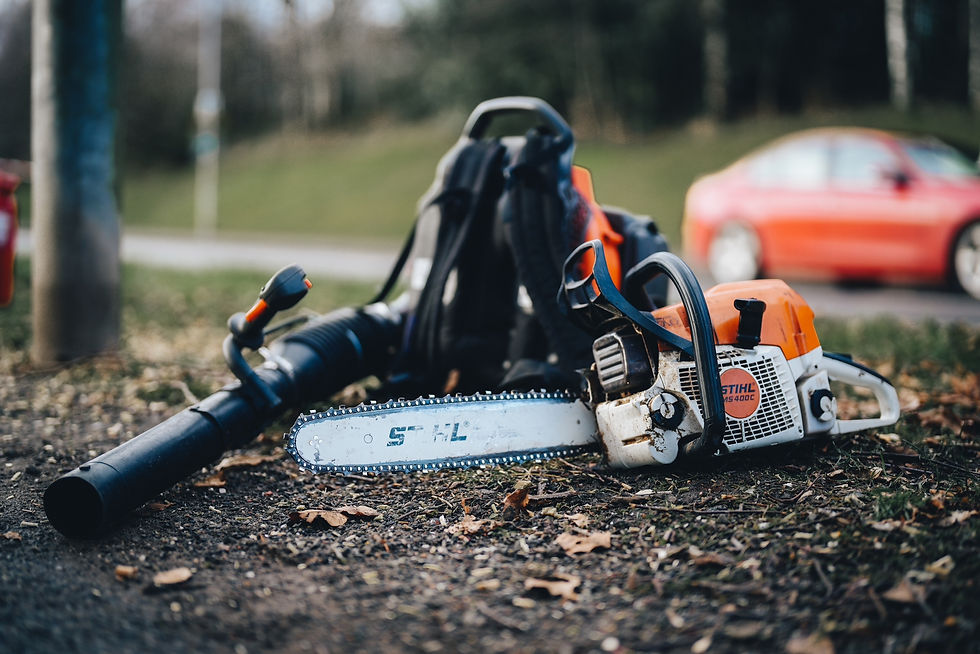Arboricultural terms
- Neil Foote

- May 5, 2022
- 3 min read
Arborists and tree surgeons train for years studying the Biology of Trees, so when we're called out to deal with a particular problem a client might have, we can give the best advice for both client and tree. Some of the tree lingo can be quite difficult for someone to understand, so in this weeks blog we're going to give a short explanation of some of the terms we use to describe your tree.

ANNUAL GROWTH RING: Trees grow in the spring and summer, the spring growth is light but as growth slows down in the summer the wood becomes darker, this dark wood is the annual growth ring. Counting these rings will give you the age of the tree.
BOLE: This is the trunk of the tree before it separates into individual limbs.
BRASH: These are the smaller branches that have been cut away from the main tree. These are typically put through our chippers.
BROADLEAF: A tree that has large flat leaves rather than needles. Broadleaf trees lose their leaf coverage in the winter.
BUTT: The end of the tree closest to the ground
CAMBIUM: The cambium layer can be found directly underneath the Bark of the tree. This layer is where all new growth comes from. Damage to the Cambium layer can lead to infection and disease in trees
CANKER: Where bacteria, fungi or aphids have damaged a tree a swollen Canker can sometimes be observed.
CANOPY: The upper leaf bearing part of a tree
CLEAR FELL: An area of woodland that has been harvested for wood.
COMPARTMENTALIZATION: This is a trees attempt to seal out infection after damage to a branch. A good pruning cut made close to the collar of the limb will seal over time.
CONIFER: A tree that has needles, and bears cones. This includes Spruce, Fire, Pine, Yew etc

CO-DOMINANT: A tree that has grown with two equally sized trunks rather than one.
COPPICE: Certain broadleaf species will regrow when the tree has been felled by sending up new growth from the stump
CROWN: The upper portion of a deciduous tree. This includes Limbs, Branches and Leaves.
CROWN LIFT: The removal of lower branches and limbs.
CROWN THIN: The removal of no more than 1/3rd of leaf bearing material within the crown
DEADWOOD: Trees will naturally shed old growth that it no longer needs, this overtime becomes dead wood. Dead wood should be removed from large trees to minimise damage below.
DECIDUOUS: A tree that sheds it's leaves during winter.

EPICORMIC GROWTH: When a tree is damaged dormant buds below the damaged area will sprout in clusters to take over the tasks of the missing limb.
ESTABLISHED: A tree or woodland is established when growth is satisfactory, nutrients are plentiful and an early risk from pest damage has been passed.
FELLING: The cutting down of tree/s
FORMATIVE PRUNING: The selective pruning of trees over 3 years old to make sure they grow with a single stem and even branches.
HEARTWOOD: The inner wood of a tree. The heartwood is dead, unlike the sapwood towards the outer bark.
LATERAL ROOTS: These are the roots that spread horizontally.
LATERAL BRANCH: These are the branches that grow sideways away from the leader.
LEADER: This is the main vertical shoot at the top of the tree
LOPPING: The cutting of branches
MAIDEN: A seedling grown from seed
MYCORRHIZAL FUNGI: Fungi that lives in the ground. A symbiotic relation ship happens between fungi and tree. The Fungi elongates the tree roots increasing nutrient uptake and in exchange take a small amount of sugar from the tree.
Ph: The scale used between; 1 High Acidity and 14 High Alkaline, 7 being neutral. In Soil science 4.5 is regarded as extremely acidic and over 9 is highly alkaline. Certain species have a proclivity to one or another.
PESTS: A biological species that has a detrimental affect on the growth of a tree.
PIONEER SPECIES: The first species of trees to grow in an area, such as Birch, Willow and Alder. Pioneers are usually sensitive to needing a lot of light.
POLLARD: The practice of topping certain species above the height of grazing animals and allowing epicormic growth to grow. Re Pollarding needs to be continued on a cycle once carried out.
PRUNING: The practice of selectively removing branches to keep a tree growing healthily. Pruning should always replicate the trees natural ability to shed unwanted/troublesome limbs and encourage healthy compartmentalization.
REDUCING: Selectively making the tree smaller to fit in to it's environment.
SAPROXYLIC: Organisms that feed on dead and decaying wood.
SAPWOOD: This is the outer layers of the wood that move water and nutrients around the tree.
SHRUB: A woody plant that sends up mutiple leaders rather than 1 like a tree.
SNEDDING: Taking the limbs and branches off the main trunk after the tree has been felled.
SOFTWOOD: Wood that is produced by conifers
TREE PRESERVATION ORDER (TPO): An order by the local authority that legally prohibits the removal of a tree.
TOPPING: The practice of cutting the top of the tree off
WINDBLOWN: A tree/trees that have been uprooted in high winds.


.png)


Comments